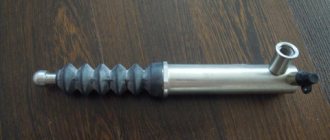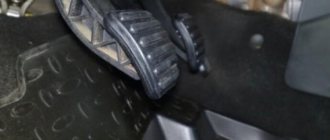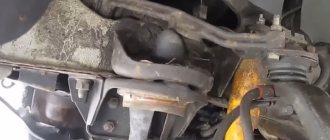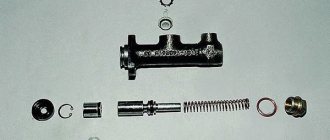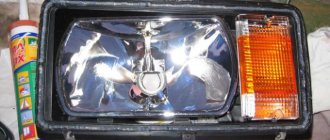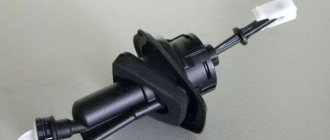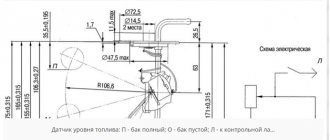Main cylinder. Unscrew the plug, remove the protective rubber cap 2 (Fig. 3-5) and the retaining ring 3. This will allow you to remove piston 4, sealing ring 5, floating piston 6 with sealing ring 7 and piston return spring 8 from cylinder body 1.
Rice. 3-5. Master Cylinder Parts:
1 – cylinder; 2 – protective cap; 3 – retaining ring; 4 – pusher piston; 5 – sealing ring; 6 – piston of the main cylinder; 7 – sealing ring; 8 – return spring; 9 – sealing gasket; 10 – fitting; 11 – lock washer; 12 – gasket.
The cylinder mirror and the outer surface of the piston must not be damaged or scratched. Check the condition of the piston spring and replace it if it has lost its elasticity.
Replace the piston cup and all sealing elements. Check the protective boot at the rear end of the cylinder and if the boot is damaged, replace it with a new one. Before assembly, carefully clean and rinse the parts with brake fluid. Do not allow mineral oil, gasoline, kerosene or diesel fuel to come into contact with parts, as these substances cause rubber seals to swell.
After checking all parts, reassemble the master cylinder in the reverse order of disassembly, in this case:
- Apply a thin layer of DT-1 lubricant on the piston surfaces in contact with the cylinder, support sleeve and pusher;
- Lubricate all other parts of the cylinder with brake fluid.
Working cylinder. Remove the protective rubber cover 6 (Fig. 3-6) together with the pusher 5, then remove the retaining ring 7. This will allow you to remove the piston 8, piston collar 9, spring cup 10 and spring 11.
Rice. 3-6. Parts of the clutch release cylinder (slave cylinder):
1 – body; 2 – transport plug; 3 – fitting; 4 – fitting cap; 5 – clutch release fork pusher; 6 – protective cover; 7 – retaining ring; 8 – piston; 9 – piston cuff; 10 – spring cup; 11 – spring.
After disassembly, carefully wash and inspect all parts as specified for the master cylinder. Installation of a deformed pusher is not allowed.
After checking, proceed with assembly (the order is reverse to disassembly), in this case:
- Apply a thin layer of DT-1 lubricant on the piston surfaces in contact with the cylinder and pusher;
- Lubricate all other parts of the cylinder with brake fluid.
Removing and installing the Chevrolet Niva clutch slave cylinder
Tools:
- Driver for 3/4 socket bit
- Knob attachment 13 mm
- Straight box spanner 13 mm
- Open-end wrench 17 mm
Parts and consumables:
- Clutch slave cylinder
- Protective case
- Brake fluid
Remove the slave cylinder for replacement or repair if the clutch does not disengage completely due to a fluid leak.
We carry out the work on an inspection ditch or overpass.
1. Using a 13mm spanner, unscrew the two bolts securing the slave cylinder bracket to the clutch housing.
2. We remove the bracket, the working cylinder and its pressure plate, installed with the convex side to the cylinder.
3. Remove the clutch release fork pusher from the cylinder.
4. We disconnect the protective cover and the pusher. If the cover is damaged, replace it with a new one.
5. Using a 17mm wrench, loosen the lower end of the hose and, by rotating the working cylinder, unscrew it from the hose.
6. The connection between the hose and the cylinder is sealed with a copper washer.
7. Install the working cylinder in reverse order.
If, when installing the slave cylinder, the hose is excessively twisted, it is necessary to loosen the fluid supply tube fitting in the upper tip of the hose, as described here. Then, by turning the upper tip of the hose, it is necessary to eliminate the twist in the hose and tighten the fitting.
8. We bleed the clutch hydraulic drive as described here.
The article is missing:
- Photo of the instrument
- Photos of parts and consumables
- High-quality photos of repairs
Source: Chevrolet niva device, operation, maintenance and repair. Publishing house "Behind the Wheel".
Source
Replacing the clutch yourself
After determining the cause of the clutch malfunction, it must be eliminated. The necessary tools are prepared in advance. To replace the clutch, socket and open-end wrenches in a set and screwdrivers are used. The clutch disc is aligned using a mandrel.
Replacement work is carried out according to the instructions:
- To conveniently carry out repair work, it is recommended to place the crossover on an inspection hole.
- To get to the devices itself, it is recommended to remove the gearbox.
- Marks are made on the flywheel and casing to help determine their location. This procedure is only necessary when using an old pressure plate after repair work.
- The spare parts have mounting bolts that can be unscrewed with a 8mm wrench. They are used to secure the clutch disc to the flywheel. To unscrew the bolts, it is recommended to first fix the flywheel.
- The driven and pressure disks are dismantled.
- The driven disk is inspected. If there are cracks, chips, or signs of wear, the disc is replaced. If the distance from the surface of the lining to the rivets is more than 0.2 millimeters, then it is recommended to discard the part and install a new one.
- The damper springs are checked for secure fastening. If they are damaged or weakened, the disk is replaced.
- The pressure spring is inspected, the petals of which are located at the same level. If this is not the case and there are signs of wear, then the part is replaced.
- If all clutch parts are in normal condition, the old driven and release plates are installed. Otherwise, these parts are replaced.
If the clutch elements are damaged, it is recommended to completely replace it. If the car is front-wheel drive, then remove the drive shafts and install plugs in their place. The bolts are unscrewed, the cables and drawstrings are disconnected. Remove the gearbox input shaft from the bearing. In rear-wheel drive vehicles, dismantle the clutch that connects the driveshaft and gearbox.
After unscrewing the basket bolts, it is recommended to remove all clutch parts that are located on the flywheel. When performing the procedure, inspect the device to determine the presence of oil on the surface. If it is greasy, it is recommended to replace the oil seal. If there are scratches and cracks on old disks, change the basket into which a new disk is inserted. After installing the basket on the flywheel, it is recommended to tighten the mounting bolts.
When the gearbox shaft rotates, you need to make sure that it is in the flywheel splines. Installation and dismantling of the gearbox on vehicles with all-wheel drive is carried out using a winch. To install the clutch, it is recommended to perform the same work as for removal, only in reverse order. At the final stage, it is recommended to adjust the clutch. In accordance with the characteristics of the vehicle, a cable or rod of a certain length is used, which ensures adjustment of the free play of the pedal.
Niva Chevrolet and clutch slave cylinder: diagnostics, repair and replacement
The presence of a clutch in cars is not accidental, and its absence makes it impossible to travel in a vehicle. For most novice drivers, the clutch is the leftmost pedal in the car. But few people know its design, and therefore in this article we will pay attention to one of the main elements of the clutch - the working cylinder on a Chevrolet Niva. What is this product, why is it needed, where is it installed and how is it repaired and replacement parts carried out? You can learn about everything from this material.
Substitution
If the part fails, and pumping and rebuilding does not help, then it is necessary to create a complete replacement; this is necessary;
- Drain all liquid from the barrel
- Disconnect the clamp that secures the pipes from the head cylinder of the system.
- We move the pipes to the side
- We unscrew the fastening element at the hydraulic tube
- So as not to interfere with the pipeline, remove it from the system and put it aside
- Unscrew the remaining nuts and remove the cylinder
After the part is repaired, it can be installed in its place in reverse order.
Purpose and design features of the working cylinder
There are two types of cylinders in the clutch mechanism: working and main. You can learn about the purpose of the main one from the corresponding article, and today we’ll look at the Chevrolet Niva clutch slave cylinder. The Chevrolet Niva clutch system is based on the operation of a hydraulic drive, which, in turn, is inoperative without a cylinder. The essence of its operation is to directly receive the force coming from the main cylinder and thereby move the clutch release fork.
The design of the working cylinder is absolutely identical for almost all car models, therefore the principle of operation of the device is the same. The product consists, first of all, of a base, that is, a body where the following parts are assembled in a certain order:
All parts are assembled in a certain sequence, which allows the device to function correctly.
The photo below shows the working cylinder of a Niva Chevrolet.
How does the device function?
To understand the issue of purpose in more detail, let’s consider how the product’s workflow is carried out. So, when you press the main control lever (i.e. the clutch pedal), the pusher moves, which acts on the piston and it moves forward. When the piston moves under the influence of mechanical force, the pressure in the housing begins to increase. This is a process that occurs in the clutch master cylinder. After increasing the pressure, the liquid begins to be squeezed out through the discharge channel and enters the working cylinder. It contains a piston with a fork, which, under the influence of pressure, squeezes out the release bearing, thereby separating the engine and gearbox. At this moment, the corresponding gear is engaged, and then the driver releases the clutch pedal. After releasing the pedal, a return to its original position is observed: the engine engages with the transmission, which is due to the action of the pushing spring in the cylinder.
This is the essence of the functioning of the working cylinder of a Chevrolet Niva SUV. You cannot do without breakdowns and malfunctions, which are inherent in any mechanism. Thus, it is periodically necessary to repair the cylinder, since its functioning is based on friction, and, therefore, wear.
Where can I find the clutch slave cylinder in my car? On the Chevrolet Niva SUV, this product is located on the clutch housing, as on almost all cars. To do this, you need to open the hood and look at the area under the hood on the driver's side.
Fault Diagnosis
Initially, it is important to make sure that this particular element is faulty and requires replacement or repair. To do this, there are ways to identify malfunctions that will allow the car owner not to resort to the help of auto repairmen. So, if you notice the following shortcomings:
Clutch cylinder in need of repair
- incomplete clutch release;
- crunching noise when changing gears;
- there is visible damage to the cylinder body;
- oil discharge from the connecting tubes of the product is noticeable;
- decrease in brake fluid level;
- complete lack of traction.
In this case, you should pay special attention to the working cylinder and promptly carry out repairs to avoid further troubles.
Cylinder replacement and repair
Replacement is carried out in the event of irreparable defects, which include damage to the cylinder body. In all other cases, repairs will be required. But first, let's look at how to remove the slave cylinder from a Niva Chevrolet SUV and install a new repair kit.
To carry out the work, you will need open-end wrenches for “13” and “17”. Let's get started:
- We find the working cylinder hose and loosen its tip, but under no circumstances unscrew it completely.
- The cylinder is attached to the crankcase using two bolts that need to be unscrewed. The bracket is removed.
- The pusher is removed from the fork, and then the protective cap with the pusher is removed.
- With one hand you need to fix the hose tip, and with the other, rotate the working cylinder until they are disconnected.
- After disconnecting, it is necessary to drain the liquid into a container.
At this stage, the removal is complete; next, you need to replace the removed element with a new one and install everything in the reverse order of removal. After installation, the system will need to be bled (to remove air from the system).
A new working cylinder for a Chevrolet Niva will cost 300-600 rubles, so don’t be upset if the product is no longer repairable.
The product is replaced in rare cases, so if a malfunction is detected in the working cylinder, it can be repaired. For the repair procedure you will need: purchase a new repair kit for the Chevrolet Niva; standard set of tools; vice.
After the cylinder has been removed from the car, you need to proceed with the following steps:
- The removed cylinder is clamped in a vice and disassembled. The rubber boot is removed along with the pusher.
- By removing the retaining ring, the piston is removed.
- The spring with the sealing gasket is removed from the piston. The gasket must be replaced with a new one.
- Next, cleaning work is carried out on the cylinder and fitting in order to clean the channels for removing air.
- If the spring looks deformed, then it should be replaced.
- It is imperative to replace the boot and seal ring.
- Before assembling the product, all existing parts must be washed with brake fluid only.
The assembly of the cylinders is carried out in the reverse order of removal, and upon completion of the work you should make sure that there are no third-party objects that may not have been installed.
After installation, you should remove air from the system, and then check the performance of the Chevrolet Niva clutch.
Worth knowing...
The question is very often asked: “Is it possible to install a working cylinder from Shevik on a classic?” Classic car drivers often want to upgrade their car. In view of this, they resort to this issue, but at the same time, without knowing what the likelihood is that the “non-native” device will function adequately. Not at all! There is no need to install a Shev cylinder on the classic, and the reason for this lies in the principle of operation. The release bearing of a classic car is not designed for the operating mode of the rod in a pressed state, which rotates. If you nevertheless install the product on a classic, you can detect early wear of the bearing.
Now you know why your car needs this device, and how you can replace it in case of damage or wear. It is very important to identify a malfunction in the unit by early signs in order to eliminate it before complete wear and tear. Happy renovation work!
Source
Bleeding the hydraulic clutch of Niva Chevrolet
During the process, no grinding noise should be heard in the gearbox. Chevrolet Niva clutch does not bleed When accelerating a car, it should not bleed Chevrolet Niva clutch speed is proportional to the increase in crankshaft rotation speed.
If the engine is running at high speeds, but the car does not accelerate dynamically, it means that the clutch is slipping. It will need to be repaired. How to determine the need to bleed the clutch This can be determined because when you engage any gear, you will hear a grinding noise in the box. This situation may indicate that air has appeared in the system. Bleed the clutch by pressing and holding the pedal. Repeat the procedure until clean fluid comes out of the system.
There should also be no air bubbles in it. Controlling the color of the liquid and air bubbles During the process, you need to check the liquid level in the tank.
If necessary, it is topped up. After pumping, add fluid to the reservoir up to the MAX mark. The clutch fluid leaked periodically. In addition, the presence of air in the system leads to such a breakdown. This problem can be eliminated by pumping.
If the disk is skewed or its surface is warped, then replacement is also necessary. There are other breakdowns that may require replacement of individual parts. Experienced motorists identify them by their characteristic symptoms. So, usually when pressing on a faulty mechanism, a characteristic noise will be heard. If it occurs only when released, this is also a sign of failure. Diagnostics of the Chevrolet Niva clutch You can carry out independent diagnostics of the mechanism of the Chevrolet Niva clutch not being pumped.
To do this, you need to perform several operations: Put the car in neutral gear.
Then start the engine and warm it up to operating temperatures. At the moment when the engine is idling, fully depress the clutch pedal. The Chevrolet Niva starts to work in reverse gear when you shift the gearbox.
How to bleed the clutch on a Chevrolet Niva
The process of pumping the Chevrolet Niva clutch occurs smoothly, easily, and without noise. If various creaks or grinding noises are heard, this indicates that the mechanism is faulty. You can check how the clutch functions while driving.
This requires shifting gears and listening carefully so that there are no noises or any extraneous sounds. A malfunction such as clutch slipping has already been noted. When the car picks up speed, the number of crankshaft revolutions should also increase in proportion to the speed.
The tachometer will help identify the breakdown. If you sharply press the gas while driving a car, and the revolutions begin to rise, the Chevrolet Niva clutch will not bleed, then drop slightly, while the car accelerates, then clutch repair is inevitable. Bleeding the hydraulic drive The list of typical faults indicated incomplete shutdown. It was also noted that the cause of this is air in the hydraulic drive. The problem can be solved by pumping.
How to replace the clutch cylinder on a Chevrolet Niva
The clutch in cars is one of the main components that ensure the movement of the vehicle. Its failure threatens to completely immobilize the device. In cars with a manual transmission, the driver directly controls this unit using the leftmost pedal located under the steering column. But in order to ensure a smoother and quieter ride, it is necessary to understand which components are activated when you press the pedal, as well as how to prevent possible malfunctions and make repairs if necessary.
The clutch mechanism includes two types of cylinders: slave and master. This material is useful if it is necessary to replace the main clutch slave cylinder. The main component of the work is the hydraulic drive, which ensures the movement of the cylinder. The operation is based on the reception of force that comes from the master cylinder, the movement of which moves the clutch release fork.
The design of the slave cylinder is almost the same in all car models with a manual gearbox, so the operating principle is the same. Typically, the following set of parts is used in manufacturing:
- retaining ring
- cap
- union
- plate
- boot and o-rings
Adjusting the Chevrolet Niva clutch
Chevrolet Niva cars have a dry clutch. It is driven by a hydraulic mechanism. If the clutch malfunctions, it needs to be adjusted. Here are a few signs that require immediate diagnosis:
- increased pedal play. If, when pressed, the pedal exceeds its travel according to the standard, this means that the clutch is not completely disengaged. In this case, the disc does not fully contact the flywheel. Untimely repairs can lead to severe wear and tear.
- Pedal travel is too small. Such a defect can lead to slipping of the gasket. At the same time, engine power drops greatly.
- The appearance of jerks when starting off. It is also possible that shocks may occur in the transmission.
The appearance of all these signs indicates the presence of problems with pedal adjustment. If they are ignored, this can lead to clutch replacement and costly repairs.
Adjustment procedure
- Adjustment of the Chevrolet Niva clutch is carried out with the engine turned off. It is also better to disconnect the battery so as not to accidentally start the engine when the shaft rotates.
- The gearbox is moved to neutral. The master cylinder is installed with a gap of half a millimeter from the pusher. This distance is sufficient to disengage the clutch disc. Subsequently, the pedal travel is adjusted.
- The pedal travel should not exceed 3 millimeters. Adjustment must be made by changing the position of the locknut and bolt. By tightening them you can adjust the stroke amount.
- The pusher should move freely no more than 4-5 millimeters. To adjust it, you need to adjust the stop nut.
- Also, to adjust the pusher, you can change the position of the lock nut.
The total free play of the pedal should be within 25-35 millimeters.
To more accurately adjust the clutch pedal, it is necessary to work on an inspection hole or lift.
The difference between adjustments on the Chevrolet Niva
The clutch in the Chevrolet Niva is reinforced. For this purpose, thickened metal of larger diameter was used. Damper springs are used for compression. The hydraulic clutch option compensates for wear.
Clutch discs are balanced when assembled. They are usually called a basket. This component is located in an aluminum housing. When adjusting the Chevrolet Niva clutch, it is necessary to install a new drive disc. The springs pressing the disk may be defective.
To avoid frequent adjustments, the device is equipped with a working cylinder. This component allows automatic clearance changes. If it fails, the assembly is replaced.
The driven disk is located between the flywheel and the shaped cup disk. A special overlay is applied to it using rivets. When worn, its thickness decreases and the rivets can scratch the disc and cause beating.
When installing, the hub must be directed towards the basket
It is important to align the hub hole and the main pin.
The driven disk with a riveted friction lining is located between the flywheel and the drive disk of the shaped cup. The disc splined bushing sits loosely on the input shaft. Replaced when worn, if the thickness of the lining decreases to 0.2 mm and the rivets begin to leave scratches on the pressure plate. The cause may be axial runout, weakening of rivets, cracks, breakages, or scuffing on the friction material body.
It is installed with the protruding part of the hub in the direction of the shaped basket. In this case, the centering pin should align with the hole in the hub.
The stamped shaped clutch release fork has a recess for a ball joint and its two ends rest against the release bearing clutch. The ends of the fork, periodically wearing out, are restored by welding pads on them to the thickness of the factory sample.
The main, working hydraulic mechanisms are communicated through a steel tube and a reinforced hose. The slave cylinder is mounted on the clutch housing using a bracket.
When the pedal is pressed, the main piston creates fluid pressure, which causes the pushrod and fork to move the release bearing clutch.
The hydraulic drive operates on DOT-4 brake fluid, the reserve of which is contained in the reservoir and communicates with the main one through a hose. Hydraulic bleeding is provided by a fitting located on the (working) cylinder.
How the device works
First of all, you need to understand what the slave cylinder is intended for. When you press the clutch pedal, a pusher moves, which drives the piston, moving it forward. This causes the pressure in the clutch master cylinder to increase in the housing. Liquid under pressure is forced through the discharge channel into the working cylinder, which contains a built-in piston and fork that drive the working cylinder. At this moment, the connection between the engine and the gearbox is broken, which allows the gear to be changed. After the driver releases the clutch pedal, a push spring returns the system to its original position and the clutch discs are connected.
Recommendations
Comments 17
How long did this cylinder last?
What will happen to him? Already 188,000 (i.e. 30,000 have passed).
Hello! I came across this question the other day. In general, a person has a 2015 Chevy Niva. It stood for about 7 months. Wheels (the brakes were unlocked). The situation with the clutch is this: the gears are engaged, and when the clutch is released in any gear, the car does not stall, and does not move. Could it be the slave cylinder that is stuck in the pressed position? With all this, the clutch pedal feels like it works as usual. Thanks in advance.
In this case, the tedal would walk completely without difficulty. But maybe. But it is even more possible that the transfer case is in neutral
